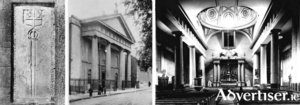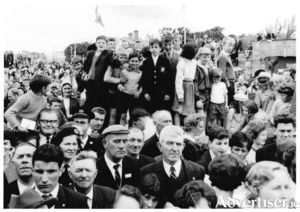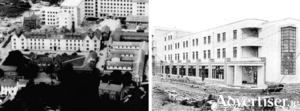The Galway Electric Light Company
Thu, Dec 05, 2024
The Galway Electric Light Company was set up by James Perry, an engineer and County Surveyor of the Western District of Galway, and his brother, Professor John Perry, to generate electricity. On November 1, 1888, they applied for permission from the Galway Town Commissioners to ‘erect poles in some parts of the town as an experiment for the electric lighting of the town’. The company had established a generating station at Newtownsmith in an old flour mill which had existed since the 1600s and straddled the Friar’s River. They installed a hydroelectric turbine in the watercourse which was linked to a generator producing alternating current.
Read more ...Some old election posters
Thu, Nov 28, 2024
Election posters are very much part of the democratic process. They are primarily used to urge people to vote, to communicate political messages, rally public support for a candidate or a cause. They play an important role in our documentary history and are often a powerful way to capture a moment in time. They can be used to educate, inform and inspire people. They also generate loyalty to the cause from the thousands of volunteers who hang the posters up. They were an especially powerful form of communications for previous generations.
Read more ...Jimmy Cranny, ‘Mr Swimming’
Thu, Nov 21, 2024
Jimmy Cranny was born in Dublin in 1905. He was orphaned early in life, came to Galway when he was eight and it became his home from then on. He grew up to be a champion swimmer, a winner of the Prom Swim and a springboard diving champion of Connacht. He was a member of the Royal Lifesaving Society and became one of their first lifeguards. He later joined the Irish Red Cross.
Read more ...Queen’s College, Galway, the early days
Thu, Nov 14, 2024
The Queen’s Colleges in Galway, Cork, and Belfast were established in 1845, and shortly afterwards, construction of the quadrangular building started in Galway. In May, 1847, despite the Famine, William Brady, the contractor for the building, advertised for 30 stone cutters and 30 stonemasons. Large working sheds were erected on the site so that the work could be carried out in inclement weather. There was no big rush to work from the stone men as the money he offered was below the going rate, but as it was a long term job with shelter provided, so it had a security of employment not available on other building projects, In the end, the building of the college did have a beneficial effect on the depressed conditions in Galway at the time.
Read more ...The Franciscans in Galway
Thu, Nov 07, 2024
In the graveyard at the back of the Abbey Church in Francis Street stands an interesting memorial carrying the De Burgo coat of arms and a long broadsword. The inscription tells us that it was erected in memory of William De Burgo who founded the Franciscan friary on St Stephen’s Island in 1296. The site was roughly where the Courthouse is today and the island was formed by the Galway River on one side and a branch of that river which ran through what today would be Woodquay and Mary Street and re-joined the main river. A second and smaller island lay between St Stephen’s and the town wall, so that in order to maintain communications with the town, two bridges were necessary, one at the junction of Mary Street and Abbeygate Street and the other at the Little Gate. The Abbey buildings lay immediately north of the present graveyard and between them and the river was ‘Sruthán na mBráthair’, a small stream that enabled the friars to bring boats in from the main river. The monastery was known as the Abbey of St Francis.
Read more ...Developments in the Claddagh
Thu, Oct 31, 2024
Towards the end of the 19th century, the Claddagh started to go into decline, thanks mainly to the local fishermen not updating their methods of fishing. This economic decline continued into the last century so, when the Urban District Council announced in 1916 that they were starting a reclamation programme of the 30-acre field that was known locally as ‘The Swamp’, it caused a lot of excitement locally. A small working committee was established to carry out the details of organisation. From then on the area was to be known as South Park. I am not sure where that title came from, maybe they regarded the Square as East Park, Salthill Park as Westpark, but where was North Park?
Read more ...Fairs and markets in the Square
Thu, Oct 24, 2024
In 1902, the number of fairs listed for Eyre Square was: January 1st; March 20th & 21st; April 14th & 15th; May 30th & 31st; June 20th; July 13th & 14th; August 6th; September 3rd & 4th, 20th & 21st; October 21st; November 2nd (pigs only); and December 8th & 9th. This list gives one an idea of how important and busy the Square was for commerce at the time. These were occasions when the country came to town, when rural people brought in their produce and hoped to convert it into cash.
Read more ...Ninety years a rowing
Thu, Oct 17, 2024
In 1934, a group of Jes boys gathered in Keogh’s shop, next to the school, to discuss the formation of a school rowing club. As there was no one on the staff to take charge, the school turned down the application but the boys were persistent and made another appeal. So, in October, 1934, the Jes Rowing Club was formed. They had to put together a crew, find a coach, get a boat and a base on the river so that they could get on the water.
Read more ...St Endas’ College, a brief history
Thu, Oct 10, 2024
On this day, October 10, 1937, Coláiste Éinde opened on Threadneedle Road for the first time. The school had been founded by the State in 1928 shortly after the State itself was founded. The aim was to teach boys through the medium of Irish so that they would go on to St Patrick’s Teacher Training College, get secure employment for life and, in turn, educate a new generation of boys through Irish.
Read more ...The age of sail
Thu, Oct 03, 2024
“A river mouth opening upon one of the finest natural harbours would seem to offer an ideal situation for a town or trading station.” These were the first words written in Professor Mary Donovan O’Sullivan’s very important history Old Galway, which would indicate her surprise that such a fine location would not have attracted a Norse settlement. Water, in the form of the sea, the river and the many streams, was a major factor in the development of the town of Galway from when the Anglo Norman invaders settled and built their castle and town.
Read more ...One hundred and fifty years of rugby
Thu, Sep 26, 2024
Queen’s College Galway Rugby Club was founded in 1874, 150 years ago, making it the oldest rugby club in Connacht. They have a long and proud history and have helped nurture and boost many rugby careers helping players to the highest levels. They were a founding club of the Irish Rugby Football Union. They won their first Connacht Senior Cup in 1897 and have managed to hold that trophy aloft many times since. Their first victory in the Dudley Cup, played for by the three Queen’s Universities, was in 1905. They have featured many times in the Bateman Cup, an exclusive competition in which clubs participate by invitation only.
Read more ...The house that Jack built
Thu, Sep 19, 2024
Our main photograph today (which comes courtesy of the National Library of Ireland) is an aerial one of part of Salthill taken in 1953. The main feature is the Warwick Hotel, the white building in the foreground. To the left of it you can see the Summerset Hotel and the little shop, An Bearna, run by James and Maura Codd. Behind the Warwick you can see Lenaboy Park and towards the top of the photograph, the newly built houses of Devon Park.
Read more ...Galway Bohemians, the early days
Thu, Sep 12, 2024
John O’Dowd got the inaugural juvenile soccer league (for boys under-16) underway in Galway in 1931-2. The clubs competing included; Crusaders, Hotspurs, Reds United, Emmetts, Unknowns, Bective Rangers and Hibernians. The swamp was the only soccer pitch available in Galway at the time. The league was a big success and this prompted the organisers to run a minor league in the 1932-33 season.
Read more ...Street festivals
Thu, Sep 05, 2024
It was Professor TP O’Neill who suggested the idea of celebrating the 500th anniversary of Galway being declared in 1484, to the then County Manager, Seamus Keating, so a Quincentennial Committee was set up. At one of the early meetings, Willy Fahy suggested the idea of street festivals as part of the programme.
Read more ...St Nicholas’ Parochial School
Thu, Aug 29, 2024
This Church of Ireland school is situated in Waterside beside the courthouse and the Town Hall, The earliest existing school records date back to 1901 to the Model School which was situated on Upper Newcastle Road. It had opened in 1852 with 400 pupils, many of whom were Catholics. This proved too much for the then Catholic bishop who set out to make way for explicitly Catholic education in Galway. He invited the Mercy Sisters and the Patrician Brothers to set up schools here and made it a ‘reserved sin’ for Catholic parents to send their children to the Model School. This resulted in 199 pupls withdrawing and meant the end of multi-denominational education in the city.
Read more ...College House and Monastery School
Thu, Aug 22, 2024
This property originally consisted of College House, fronting on Market Street, and the Monastery School to the rear of Bowling Green with the residence of the Patrician Brothers to the east of the enclosed quadrangle and the out offices to the west thereof.
Read more ...Galway Cathedral
Thu, Aug 15, 2024
The first bishop of the Diocese was George Browne (1831-1844). He was followed by Lawrence O’Donnell (1844-1855); John McEvilly (1955-1883); Francis Carr (1883-1888); Francis McCormack (1888-1908); Thomas O’Dea (1908-1923); Thomas Doherty (1923-1936); and Michael Browne (1937-1976).
Read more ...Galway’s early association with the theatre
Thu, Aug 08, 2024
We know from the Corporation record books that theatrical performances were given in the Tholsel, the Town Hall of the day, as far back as 1619-20. These groups of ‘strolling players' were usually sponsored by local gentry and were regarded as an important feature of festive gatherings.
Read more ...Galway hospitals
Thu, Aug 01, 2024
We know there was a hospital in High Middle Street in 1509, though it was probably a poorhouse in reality. In 1542, the Corporation built St Bridget’s Hospital on Bohermore. It subsequently served as a Leper Hospital. The 1651 map of Galway shows four hospitals. In 1820, a fever hospital opened on Earl’s Island, and in 1824, a small lying-in hospital was established on Mill Street at Madeira Island. The County Infirmary opened on Prospect Hill in June 1802.
Read more ...Seapoint Ballroom
Thu, Jul 25, 2024
Last week we were writing about Cremen’s Health Spa and Sea Baths at Seapoint, and how the complex was bought out by Salthill man, Noel Finan in 1944. He closed down the baths in 1946. He realised that young Galway people wanted something more than the clean invigorating air and to be clean, so he sold the family pub (now Killoran’s) and borrowed heavily from the EBS to build a first class ballroom and restaurant. The restaurant was 4,000 square feet, had 90 tables and could seat 350 diners. Attached to it was a kitchen with the most modern steam and electric equipment. The ballroom had a floor area of 5,200 square feet and was laid with a specially sprung maple floor capable of accommodating more than 2,000 dancers. It also had a balcony which could seat a few hundred people and from which patrons could spot the talent and could, from a distance, comment safely about them.
Read more ...



















